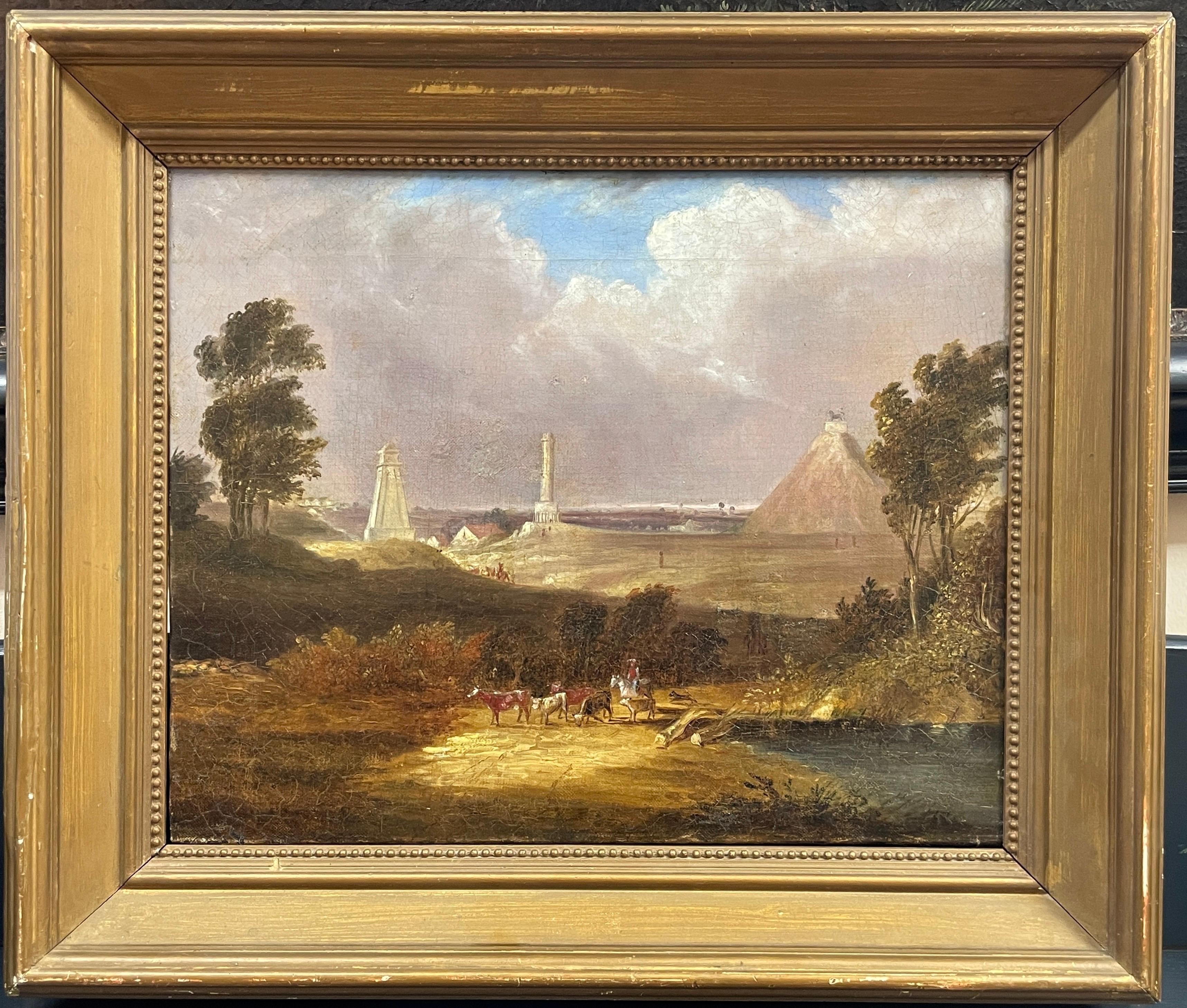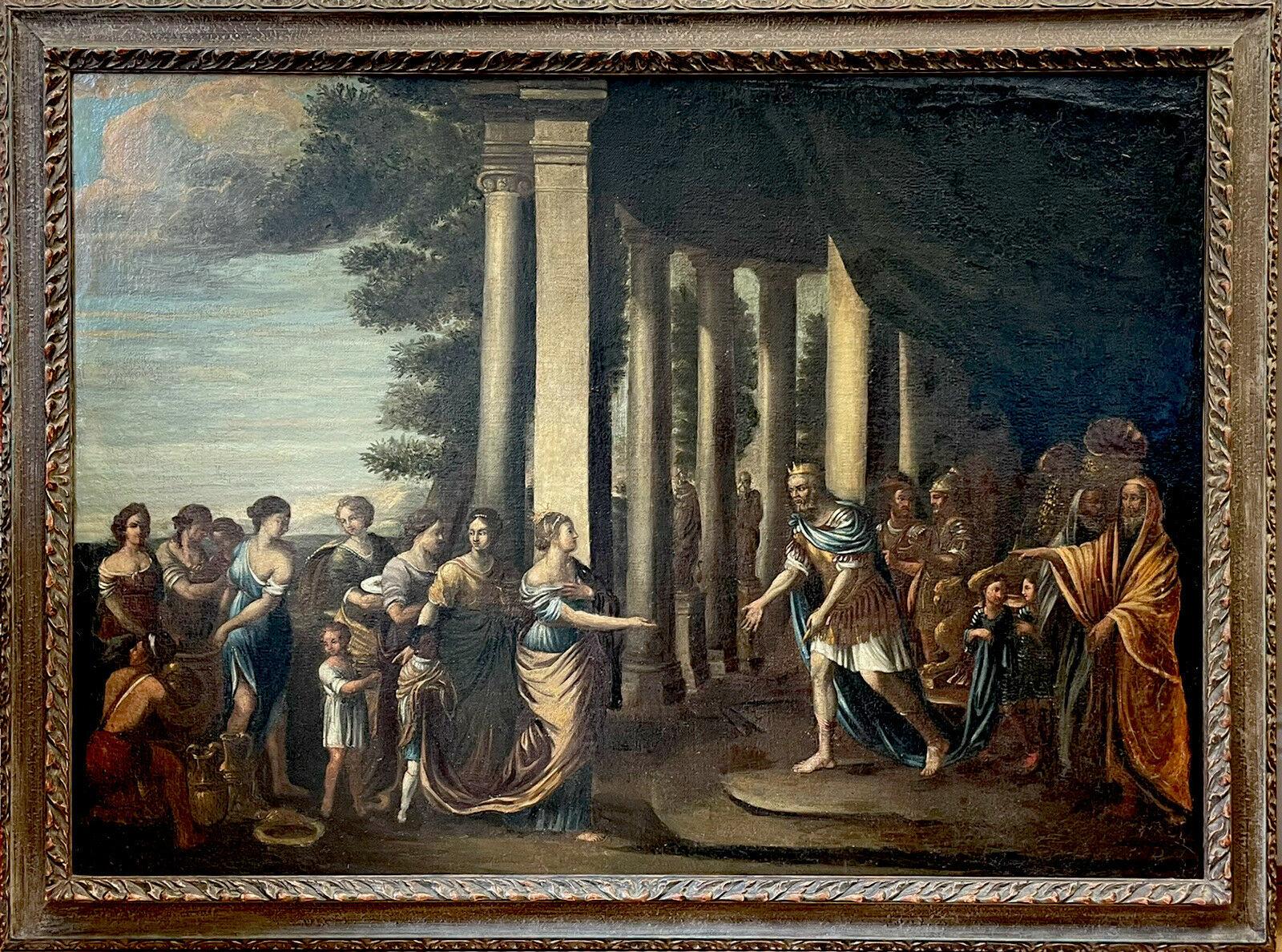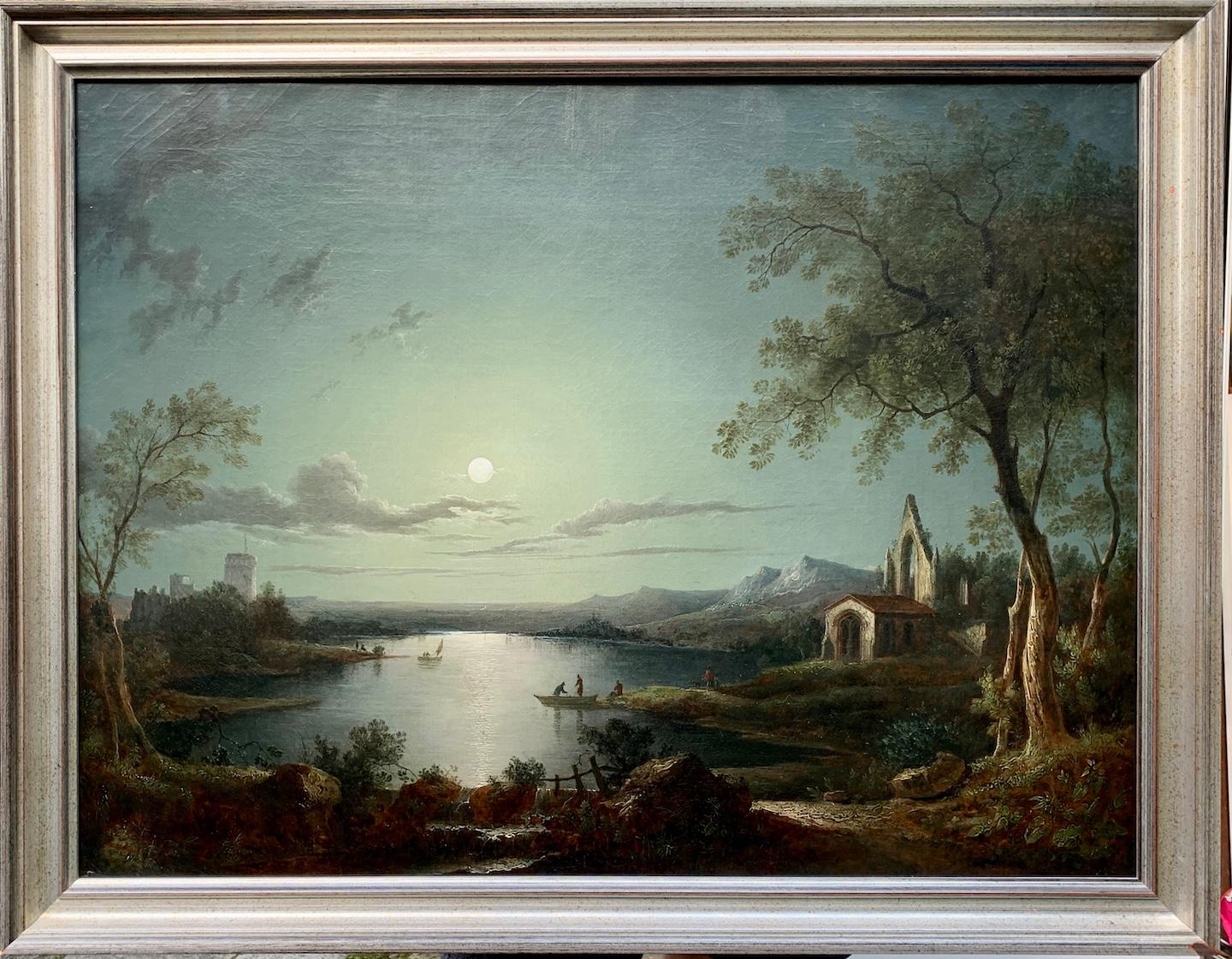Items Similar to Two countrywomen with a donkey - Melancholy in an atmosphere of colour -
Video Loading
Want more images or videos?
Request additional images or videos from the seller
1 of 6
Pierre Louis De La RiveTwo countrywomen with a donkey - Melancholy in an atmosphere of colour -around 1790
around 1790
About the Item
Pierre Louis De La Rive (1753 Geneva - 1817 Geneva). Two countrywomen with a donkey. Oil on canvas, mounted, 27 x 20 cm (visible size), 37 x 31 (frame), monogrammed "P.R." at lower right.
About the artwork
De La Rive has taken the typical scenes of Dutch landscape genre paintings by Philips Wouwerman or Nicolaes Berchem and given them a new artistic content. The landscape, but also the figures, dissolve into the atmosphere in a way reminiscent of Claude Lorraine's lighting design, so that the depiction exudes an elusive luminosity. The whole scene has a Watteau-like, dreamlike quality, which is further emphasised by the stillness of the group of figures. In addition, the women, looking in different directions and seemingly focused on nothing in particular, create a moment of timeless pause that lends a melancholy touch to the dreamlike atmosphere, which is softened by the warm pastel tones.
De La Rive's keen sense of atmospheric colour temperature, combined with a free brushstroke, anticipates the ideas of Impressionism.
About the artist
Between 1769 and 1773, De la Rive trained himself under the guidance of Nicolas-Henri-Joseph de Fassin in the Geneva collections, particularly the landscapes and animals of Philips Wouwerman, Nicolaes Berchem and Paulus Potter. In Dresden, he then discovered Claude Lorrain, whose use of light was to have a decisive influence on his work. Between 1784 and 1786, he completed the classical Grand Tour, visiting Rome, Naples and Paestum, where he became friends with Jean-Pierre Saint-Ours and Antonio Canova. Between 1789 and 1792, inspired by the surroundings of Geneva, De la Rive turned to bucolic-idealistic landscape painting, which was to be his artistic breakthrough. In 1794, he fled the revolutionary upheavals to Berne, where he continued to work on his 'tableaux dessinés', which he had developed in the Alps of the Bernese Oberland. These are large-format washed drawings which, in the manner of Lorrain's light effects, create a special luminous atmosphere. In 1810 and 1812, the Empress Joséphine commissioned such paintings from De la Rive.
As the founder of Genevan landscape painting, Pierre-Louis De la Rive was the subject of a major monographic retrospective in Geneva in 2002, demonstrating the international importance of this artist.
Selected Bibliography
Dubois-Melly: P.L. De la Rive et les premières expositions de peinture à Genève. 1769-1834, Genève 1868.
Fromer-Im Obersteg, Liselotte: Die Entwicklung der schweizerischen Landschaftsmalerei im 18. und frühen 19. Jahrhundert, Basel 1945.
Dessins de Pierre-Louis De La Rive (1753-1817), Genève 1969.
Pianzola, Maurice: Paysages romantiques genevois. Musée d’art et d’histoire, Genève 1977.
Patrick-André Guerretta (Hg.): Pierre-Louis De la Rive ou la belle nature. Vie et ouvre peint (1753 - 1817). Catalogue de l'exposition Pierre-Louis De la Rive (1753 - 1817) et le paysage à l'âge néoclassique, Musée Rath, Genève 7 février - 5 mai 2002, Genève 2002.
Thank you for your interest! I hope I have been able to explain to you the special character of the artwork. If you have any questions of any kind, please feel free to contact me.
I wish you many more discoveries in the realm of art,
Dr Martin Kirves
GERMAN VERSION
Pierre Louis De La Rive (1753 Genf - 1817 Genf). Zwei Landfrauen mit einem Esel. Öl auf Leinwand, doubliert, 27 x 20 cm (Innenmaß), 37 x 31 (Rahmen), rechts unten monogrammiert "P.R.".
zum Werk
Auf die typischen Szenen der niederländischen Landschaftsgenredarstellungen eines Philips Wouwerman oder Nicolaes Berchem zurückgreifend verleiht De La Rive diesen Vorlagen einen neuen künstlerischen Gehalt. Die Landschaft, aber auch die Figuren werden auf eine an Claude Lorraine Lichtgestaltung geschulten Weise ins Atmosphäre aufgelöst, so dass die Darstellung eine nicht näher zu fassende Leuchtkraft verströmt. Die ganze Szenerie gewinnt eine watteauartige Traumhaftigkeit, die durch die Bewegungslosigkeit der Figurengruppe noch zusätzlich unterstrichen wird. Zudem etablieren die in verschiedene Richtungen blickenden, scheinbar nichts Bestimmtes fokussierenden Frauen einen Moment zeitlosen Innehaltens, was der traumartigen Atmosphären einen melancholischen Zug verleiht, der durch die warmen Pastelltöne jedoch abgemildert wird.
Diese Bild führt in ganz besonderer Weise De La Rives sensibles Empfinden für atmosphärischen Farbtemperaturen vor Augen, die zusammen mit dem freien Pinselduktus durchaus impressionistische Bildideen vorwegnehmen.
zum Künstler
Zwischen 1769 und 1773 schulte sich De la Rive unter Anleitung von Nicolas-Henri-Joseph de Fassin in den Genfer Sammlungen insbesondere an Landschafts- und Tierdarstellungen von Philips Wouwerman, Nicolaes Berchem und Paulus Potter. In Dresden entdeckte er dann Claude Lorrain, dessen Lichtregie für sein Oeuvre richtungsweisend wurde. Zwischen 1784 und 1786 absolvierte er die klassizistische Grand Tour und hielt sich in Rom, Neapel und Paestum auf, wo er mit Jean-Pierre Saint-Ours und Antonio Canova in freundschaftlichem Kontakt stand. In den Jahren 1789-1792 wandte sich De la Rive - von der Genfer Umgebung inspiriert - der bukolisch-idealen Landschaftsmalerei zu, mit der ihm der künstlerische Durchbruch gelang. 1794 flüchtete er vor den revolutionären Umtrieben nach Bern, wo De La Rive angesichts der Alpen des Berner Oberlandes die von ihm entwickelten „tableaux dessinés“ weiter kultivierte. Dabei handelt es sich um großformatige lavierte Zeichnungen, die eine besondere, auf Lorrains Lichtwirkungen basierende durchleuchtete Atmosphäre entfalten. 1810 und 1812 bestellte Kaiserin Joséphine solche Bilder bei De la Rive.
Als Begründer der Genfer Landschaftsmalerei wurde Pierre-Louis De la Rive 2002 eine große monografische Retrospektive in Genf gewidmet, die den internationalen Rang dieses Künstlers aufgezeigt hat.
Auswahlbibliographie
Dubois-Melly: P.L. De la Rive et les premières expositions de peinture à Genève. 1769-1834, Genève 1868.
Fromer-Im Obersteg, Liselotte: Die Entwicklung der schweizerischen Landschaftsmalerei im 18. und frühen 19. Jahrhundert, Basel 1945.
Dessins de Pierre-Louis De La Rive (1753-1817), Genève 1969.
Pianzola, Maurice: Paysages romantiques genevois. Musée d’art et d’histoire, Genève 1977.
Patrick-André Guerretta (Hg.): Pierre-Louis De la Rive ou la belle nature. Vie et ouvre peint (1753 - 1817). Catalogue de l'exposition Pierre-Louis De la Rive (1753 - 1817) et le paysage à l'âge néoclassique, Musée Rath, Genève 7 février - 5 mai 2002, Genève 2002.
Vielen Dank für Ihr Interesse! Ich hoffe, ich habe Ihnen den besonderen Charakter des Kunstwerks näherbringen können. Bei Fragen jeglicher Art können Sie mich gerne kontaktieren.
Ich wünsche Ihnen noch viele Entdeckungen im Reich der Kunst,
Dr. Martin Kirves
- Creator:Pierre Louis De La Rive (1753 - 1817, Swiss)
- Creation Year:around 1790
- Dimensions:Height: 10.63 in (27 cm)Width: 7.88 in (20 cm)
- Medium:
- Movement & Style:
- Period:1790-1799
- Condition:
- Gallery Location:Berlin, DE
- Reference Number:1stDibs: LU2438211895842

About the Seller
5.0
Vetted Seller
These experienced sellers undergo a comprehensive evaluation by our team of in-house experts.
Established in 2014
1stDibs seller since 2023
7 sales on 1stDibs
Typical response time: 3 hours
- ShippingRetrieving quote...Ships From: Berlin, Germany
- Return PolicyA return for this item may be initiated within 14 days of delivery.
More From This SellerView All
- Autumn Landscape in Sunlight - Indian Summer -Located in Berlin, DEFrederick Vezin (1859 Torresdale Philadelphia - 1933 Düsseldorf), Autumn Landscape in the Sunlight, oil on canvas, mounted on cardboard, 32 x 41 cm (inside measurement), 44 x 51 cm (...Category
Early 1900s Impressionist Landscape Paintings
MaterialsOil, Cardboard
- Landscape with Trees by a Lake - Eternal summer silence over an abysmal lake -Located in Berlin, DEAndreas Thomas Juuel (1816 Copenhagen - 1868 Copenhagen). Summer landscape with tall deciduous trees by a lake. Oil on canvas, 54,5 x 42 cm (visible size), 71 x 58 cm (frame), signed...Category
1850s Realist Landscape Paintings
MaterialsOil
- Children with geese in the light of a summer eveningLocated in Berlin, DEMagda Kremer (*1942 Hengelo), Children with geese in the light of a summer evening. Oil on canvas, 40 x 50 cm (inside measurement), 52 x 62 cm (frame), signed by hand with "M.[agda] ...Category
Mid-20th Century Realist Figurative Paintings
MaterialsOil
- Late Summer River Landscape / - Realistic Impression -By Jan Hillebrand WijsmüllerLocated in Berlin, DEJan Hillebrand Wijsmuller (1855 Amsterdam - 1925 ibid.), Late Summer River Landscape, oil on canvas, relined, 34 x 56 cm (inside measurement), 43 x 64 cm (frame), signed J[an] H[illebrand] Wijsmuller at lower right. - in good condition, the frame with isolated bumped spots - Realistic Impression - About the artwork The panoramic landscape format shows a river landscape, with the course of the river, which curves to the right, leading the eye into the depths of the picture and tempting it to continue the landscape in the imagination beyond the visible area. At the same time, however, the fact that the landscape is not visible through the bend in the river focuses our gaze on the entirety of the landscape depicted, without prompting us to focus on distant details. Accordingly, the brushstroke is not designed to render details with realistic precision. In the front left area of the river there is even a completely free brushwork, trained by Impressionism, which nevertheless remains committed to representational and convincingly suggests the movement of the water. Regardless of the distance of the observer, the entire picture is painted with the same broad brushstroke, so that the landscape is given as an impression. And yet this impression is not ephemeral, as in the case of French Impressionism, to put it exaggeratedly, but reveals to us the essence of the landscape in all its richness. This is why the Dutch variant of Impressionism is always also a realism, although the pictures appear less progressive, but still contain a dimension of landscape painting that is lost with progress. In the impression, the reality of the landscape is revealed, and this happens as we experience the landscape in the visual impression. Wijsmuller does not depict houses or people in order to allow the experience of the landscape to fully unfold. The experience is determined first and foremost by the river, which does not flow into the picture from our point of view, but towards us. Where the river begins to bend, the water is churned by a rapids. Toward us, the riverbed widens and the water comes to rest, covering the entire width of the foreground like a mirror. The stillness of the water corresponds to the evening mood of the late summer landscape, in which the warm tones of the evening light blend with the yellow and brown tones of the plants. A gentle, almost idyllic reality, carried by the brushstroke, yet animated by a liveliness that is also made visible by the brushstroke. The broad, dynamically placed brushstrokes evoke the movement of the treetops and animate even the immobile reeds, while the trunks on the right bank, executed in virtuoso white strokes that seem like markings, make the sunlight shine. On the other bank, a carpet of light also spreads out, its energetic effect again expressed in the brushstroke. The dynamic of the landscape is further enhanced by the complementary color contrasts between the greens, yellows, and browns on the one hand and the blue of the all-encompassing sky on the other. A contrast that is intensified by the reflection in the water. The evening coming to rest of the landscape is thus at the same time an all-encompassing contrasting and yet in itself harmonious movement. This reality becomes accessible to us as an experience in the impression of the landscape. About the artist Jan Hillebrand Wijsmuller entered the Royal Academy of Arts in Amsterdam in 1876 and studied under the innovative Professor August Allebé, who was famous for the Amsterdam Impressionism, also known as the Allebé School. In 1877, Wijsmuller transferred to the Hague Academy of Art, and thus to the Hague School, and then completed his studies at the Brussels Academy of Art. Returning to the Netherlands, Wijsmuller opened his own studio in Amsterdam. In 1883 he won the prestigious Young Artist Award, donated by Willink van Collen, which made Wijsmuller a well-known and sought-after artist. Wijsmuller was a member of the Societät Arti et Amicitiae Amsterdam and the Pulchri Studio in The Hague. Wijsmuller belongs to the second generation of the Hague School. While Vincent van Gogh described the protagonists of the first generation to his brother Theo as "the great gray people," the second generation, and Wijsmuller in particular, used a much more colorful palette. His oeuvre makes him a major player in Dutch Impressionism...Category
1890s Impressionist Landscape Paintings
MaterialsCanvas
- Mary Magdalene - Faith transforms inner into outer beauty and conquers death -By Balthasar DennerLocated in Berlin, DEBalthasar Denner (1685 Hamburg - 1749 Rostock). Mary Magdalene. Oil on copper, 37 × 32 cm (visible size), 45 x 40 cm (frame), signed and indistinctly dated "Denner 17(...)" at centre...Category
1720s Old Masters Figurative Paintings
MaterialsCopper
- Half-length portrait of an elderly bearded man - Melancholy of a prophet -Located in Berlin, DEFriedrich August Seitz (1902 Staffort - 1944 Belgrade). Half-length portrait of an elderly man with a beard. Oil on canvas, 42 x 34 cm (visible seize), 58 x 50 cm (frame), signed and...Category
1920s Expressionist Figurative Paintings
MaterialsOil
You May Also Like
- 17th Century by Simone Cantarini Adoration of The Magi Painting Oil on CanvasLocated in Milano, LombardiaSimone Cantarini (Pesaro 1612 - Verona 1648) Adoration of the Magi Oil on paper applied to canvas, cm. 16,5 x 24 – with frame cm. 22 x 29 Antique sh...Category
Early 17th Century Old Masters Figurative Paintings
MaterialsCanvas, Cotton Canvas, Oil
- Waterloo Battlefield with 3 Monuments - Butte du Lion, Antique Oil PaintingLocated in Cirencester, GloucestershireThe Battlefield of Waterloo English School, 19th century original oil painting on canvas, framed canvas: 12 x 15.5 inches framed: 17.5 x 20.5 inches condition: overall very good and presentable, some former restoration and signs of retouching visible. provenance: from a private collection A very rare and historically important early painting, depicting the Waterloo battle...Category
Early 19th Century Old Masters Landscape Paintings
MaterialsOil, Canvas
- The Parade of Swiss Guards a painting on canvas by Gabriel de Saint-AubinLocated in PARIS, FRIn this painting, Gabriel de Saint-Aubin, the great chronicler of the reign of Louis XV, takes us to the annual parade of the Swiss Guards at the Plaine de...Category
1760s Old Masters Figurative Paintings
MaterialsCanvas, Oil
- Massive 1600's Dutch Golden Age Old Master Oil Painting Figures in Chateau ParkBy David VinckboonsLocated in Cirencester, GloucestershireFigures in a Chateau Parkland Court Setting Dutch Golden Age, early 1600's period circle of David Vinckboons (Dutch 1576-1632) oil painting on canvas, unframed canvas measures: 55 x ...Category
Early 17th Century Old Masters Figurative Paintings
MaterialsCanvas, Oil
- HUGE 17thC ITALIAN OLD MASTER OIL PAINTING - KING & COURT FIGURES ROMAN BUILDINGLocated in Cirencester, GloucestershireArtist/ School: Italian School, 17th century. Title: A King and Queen before court figures, amidst a classical landscape with Roman columns. Medium: oil painting on canvas, framed ...Category
17th Century Old Masters Figurative Paintings
MaterialsOil, Canvas
- Late 18th century Antique English Moonlight over a lake and church landscapeBy Henry PetherLocated in Woodbury, CTHenry Pether, late 18th-century Moonlight lake Landscape. Born into a family of artists, Henry was the son of Abraham Pether (1756-1812), a talented la...Category
1790s Old Masters Landscape Paintings
MaterialsCanvas, Oil





